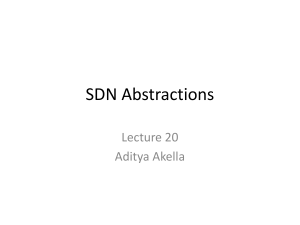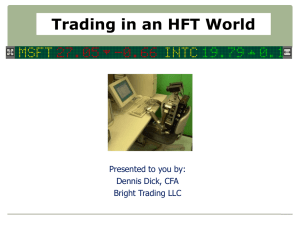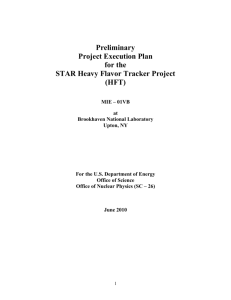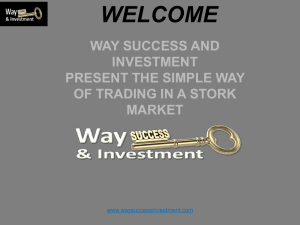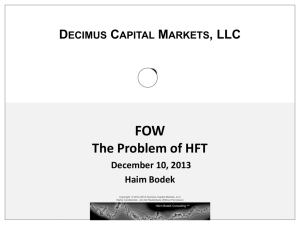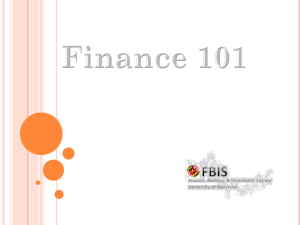1. HFT - Brussels Exchange Forum
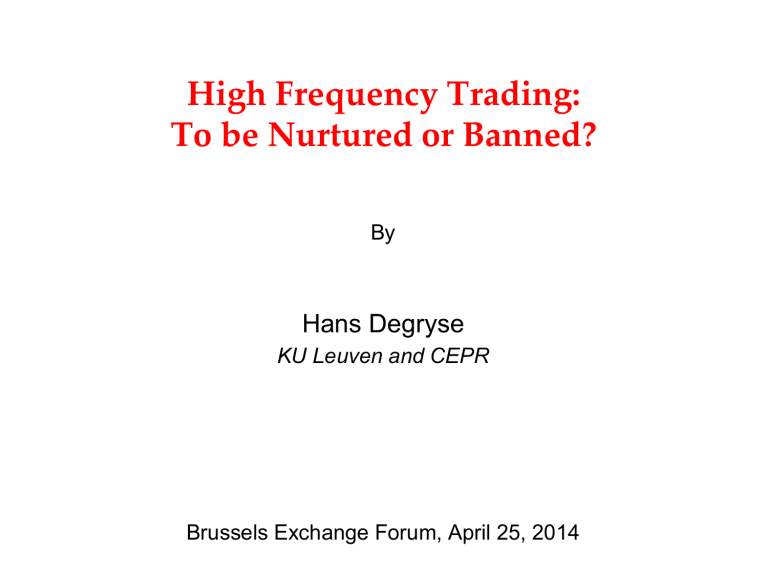
High Frequency Trading:
To be Nurtured or Banned?
By
Hans Degryse
KU Leuven and CEPR
Brussels Exchange Forum, April 25, 2014
Hot topic
• Michael Lewis book “Flash Boys”
• Investigation by FBI
…
Let me aim to summarize academic evidence …
Outline
1. High Frequency Trading (HFT):
– Definition
– Identification
– HFT in the US and Europe: some stylized facts
2. Impact of HFT: what does theory suggest?
3. HFT and market quality
4. HFT and market stability
5. HFT, social welfare and regulatory responses
1. High-Frequency Trading: Definition
Difficult animal to define. SEC (2014) defines them as:
1. Use of extraordinarily high speed and sophisticated programs for generating, routing, and executing orders.
2. Use of co-location services and individual data feeds offered by exchanges and others to minimize network and other latencies.
3. Very short time-frames for establishing and liquidating positions.
4. Submission of numerous orders that are cancelled shortly after submission.
5. Ending the trading day in as close to a flat position as possible (that is, not carrying significant, unhedged positions overnight).
1. HFT: Identification
Different methods
1. Direct classification based upon trader IDs, i.e. HFT Flag
– E.g.
NASDAQ dataset ( used by e.g. Brogaard, Hendershott and Riordan (2013),
Hirshey (2013), Zhang (2013)); ESMA dataset (Degryse, De Winne, Gresse and
Payne (in progress))
– Pure HFT firms
– Typically all HFT flags have co-location
2. Quantitative method employing “order-to trade ratios”, “intraday inventory management”, or “order modification and cancellation speed”
–
Apply to all IDs, apply to specific trades
–
E.g.
E-mini datasets (e.g. Kirilenko et al. (2011)); Canadian dataset (e.g.
Malinova, Park and Riordan (2013), Euronext (e.g. Verschelden (2014)).
1. HFT: stylized facts (US)
1. HFT: stylized facts (Europe)
1. HFT: stylized facts (Europe (2))
• HFT more important on Multilateral Trading Facilities than Regulated Markets
1. HFT: stylized facts (Europe (3))
• Order-to-trade ratios of HFT much larger than other participants
1. HFT: stylized facts (Europe (4))
• HFT more active in stocks that are more fragmented across trading venues ->
HFT “klit” together different trading venues (see Menkveld (2014))
1. HFT: stylized facts – general
•
HFT is not a monolithic phenomenon but encompasses a diverse range of trading strategies
•
Not all HFT trading is passive
•
NASDAQ dataset (Brogaard, Hendershott and Riordan (2013)): more than half of trading is attributable to liquidity taking (market) orders, even more so in small cap stocks
• UK dataset (Benos and Sagade (2012)): less than half of trading is liquidity taking
•
HFT much less active in small stocks in the US; seems less the case in
Euronext (Verschelden (2014))
•
Quite some variation across countries within Europe (ESMA (2014))
2. HFT – Theory
•
Theory essentially models two forces : speed and information
•
Implications for HFT, other traders, social welfare
1) Speed
•
Hoffmann (JFE forth)
• fast traders reduce exposure to picking off risk -> beneficial for HFT and social welfare
•
Presence of fast traders changes strategies of slow traders that submit limit orders with a lower execution probability such that trading rate declines
• Speed endogenized: speed is market power and allows to extract rents from slower traders => arm’s race leading to overinvestment from a social welfare perspective
• Calls for randomized “speed bumps” as now inplemented in some FX markets
•
Menkveld and Jovanovic (2012):
•
HFT may lead to more competition reducing spreads
2. HFT – Theory (2)
2) Information – advantage of machines over humans is ability to process vast amounts of information at superhuman speed
•
Jovanovic and Menkveld (2012):
•
HFT process hard information faster which lowers adverse selection for them
•
But they throw an adverse selection problem on others
• Calibration exercise shows that social welfare improves
•
Biais, Foucault and Moinas (2013):
•
HFT have a higher likelihood of finding trading opportunities which induces a higher trading rate which is good for welfare
• but HFT expose in this way adverse selection on others reducing trading rates and thus welfare.
3) Combination of these two:
•
Bernales and Daoud (2013)
•
HFT benefit in two ways: (1) picking off “stale” orders (2) react faster on information => slow traders modify their strategies and trade more through market orders
•
Benefit or cost to slow traders depends on their relative presence: if many slow traders, picking off risk dominates and they are worse off; if few slow traders, HFT are beneficial.
•
HFT with informational advantage is good for welfare; HFT with only speed advantage is bad for welfare; having both is better for welfare => suggests 70% of HFT is optimal
•
Bongaerts and Van Achter (2013):
• endogenize number of HFT and slow traders => HFT drive some slow traders out of market.
• With substantial asymmetric information, HFT shun the market inducing slow traders also to leave => endogenous market freezes and small crashes.
3. HFT and Market Quality
•
Fragmentation in “lit markets” (proxy for HFT) improved market quality but dark trading decreased it (see e.g. Degryse, de Jong and van Kervel (2013))
•
HFT effect on market quality:
•
Passive HFT strategies have beneficial effects: lower spreads and intraday volat
•
Jovanovic and Menkveld (2012) find that the entry of a large, primarily passive HFT reduces spreads by 15% in Dutch markets
•
Malinova, Park and Riordan (2013) exploit chock in exchange fees that affect HFT traders and find that bid-ask spreads increase in Canadian markets
•
Liquidity consuming activities of HFT less beneficial:
•
More price impact (Zhang and Riordan (2011) for large stocks, Zhang (2013),
Brogaard, Riordan and Hendershott (2013))
•
Competition between HFT harmful?
•
Breckenfelder (2013) finds that when HFT compete there are more liquidity consuming trades by HFT
•
HFT may lead to “ghost liquidity” for slow traders
• van Kervel (2013) shows that trades executed in one venue lead to substantial cancellations on other venues
4. HFT and Market Stability
• Do HFT increase financial instability and systemic risk in financial markets?
• Example: the flash crash, May 6, 2010
• Role of HFT in Flash Crash (see e.g. Kirilenko (2011)): not triggering the shock but maybe deepening the volatility
• Hagstromer and Norden (2013): more passive HFT activity reduces intraday volatility.
• Systemic risk concern:
• HFT have little capital
• HFT trade a lot with each other -> contagion?
5. HFT, Social Welfare and Regulatory Responses
•
Evidence suggests that market quality has improved and markets may have become more informational efficient
•
Should be beneficial to firms and real economy
•
However,
•
Slow traders may need to change trading strategy and may ultimately be worse off => switch from limit orders to market orders
•
Is gain in informational efficiency socially productive? Information would have been incorporated at slightly lower speed anyhow
•
HFT may improve slow traders outcomes when they act as market makers, but reduce slow trader welfare when picking-off risk increases
•
Should HFT be allowed to buy preferential treatment? Probably not!
•
Earlier access to information releases is disturbing fair level playing field
•
Co-location for every one -> should look into business model of RM and MTF to see how this is allocated
5. HFT, Social Welfare and Regulatory Responses (2)
•
Regulatory responses:
•
Fair level playing field in terms of access to information
•
If HFT by quote stuffing or excessive order flow delay other participants -> introduce order withdrawal fees; but difficult to separate
“good” from “bad” order flow
•
MiFID II: HFT strategies subject to regulatory authorization
•
Change market structure: batch auctions every “xxx” milliseconds
•
Some concluding thoughts
•
HFTs have allowed new trading platforms to arrive and have induced competition in trading and post-trading fees. Both are important as
“cum-fee liquidity” has improved substantially
(see e.g. Colliard and Foucault
(RFS2012) and Degryse, Van Achter and Wuyts (2013))
•
In sum, HFTs have been beneficial but regulators need to take care of potential externalities
•
Too much dark trading might be a more important concern (MiFID II)

